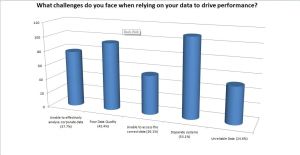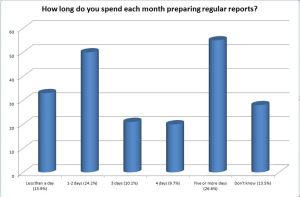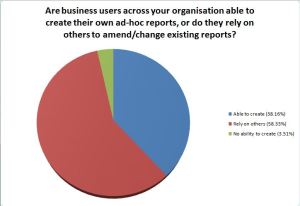Category: Mobile BI
Dude, where’s my laptop?
So this is the first overseas trip in recent memory where I do not have a laptop with me. It feels strange. You might say, a bit of a gamble…

It doesn’t seem so long ago that “Mobile BI” was realistically BI running on a laptop, and the early attempts at BI on smartphones really little more than a gimmick. Security was typically the first objection raised (either “I don’t want corporate data stored on a mobile device” or “I don’t want my corporate data stored offshore” eg Canada…).
Adoption rates of mobile devices is far outpacing previously observed adoption rates of Internet or desktop-based technologies. In fact, Gartner predicts 1/3 of BI content will be consumed on mobile devices by 2013.
So why the rapid adoption? First, and perhaps most importantly, the increased ‘form factor’. Smart phones were really too small for interfaces of much sophistication, but with the advent of the iPad and other tablet devices, we now have an interface large enough for “real” applications. Secondly, improvements made around security like secure critical infrastructure systems (more if this in a moment). Add in the potential for improved productivity (faster time to decisions, end-user self-service) and we are finally starting to see the “democratization” (is that a word?) of BI.
One critical area for BI vendors to get right right is the UI itself. My 4 year old son is already a proficient iPad user, and if an iPad App doesn’t work the way he expects (ie natively, supporting gestures like pinch and zoom), then he exits out in disgust and declares “It’s broken!”. So treating mobile devices like “just another interface” or ‘supporting’ mobile devices via the browser rather than a native App has the potential to create user dissatisfaction. As Lalitha Chikkatur recently wrote: “The important thing to remember… is that mobile BI is not just a mobile version of traditional BI; it is a mistake to overlook the unique considerations required for implementation.’’ (“10 Mistakes to Avoid in Mobile BI Delivery”, Information Management).
A key challenge in the past has been security. Now, mobile device vendors are starting to address these concerns which is reducing the barriers to adoption from corporate IT. Seven device policies are currently supported:
1. Require email session encryption.
2. Wipe devices if they are lost or stolen.
3. Protect devices with a passcode lock.
4. Autolock devices after periods of inactivity.
5. Autowipe devices after failed unlock attempts.
6. Protect the configuration profile.
7. Continuously refresh policies.
With Enterprise Security improved, reduced cost (compared to, for example, laptops), improved/unlimited data plans (in some countries at least..), improved form factor enabling business applicability, it is easy to see why analysts are predicting such a huge uptake in Mobile BI over the next few years:
“Forrester predicts that this future generation of mobile devices will eclipse the use of traditional laptops for mobile BI applications within three to five years”
(Boris Evelson – A Practical How-To Approach To Mobile BI, March 2011)

Here in the US, I’m finding that WIFI is available, for free, in many places eg malls, shops, hotels – thus enabling me to avoid the need to activate my iPad SIM (and incur very expensive Australian data roaming charges).
Now, With VPN, secure ‘Cloud’ data solutions like Dropbox and iDisk, Office-compatible and other related business Apps on my iPad (including Roambi ES for SAS!!), I hope to find that I’m not missing my laptop too much. Let’s see how that goes…
Update:
Here are some things that I’ve noticed after a week or so with only my iPad and iPhone….
- WIFI is not always reliable. While some may advocate a WIFI-only infrastructure strategy as ‘good enough’, I have found it at times frustrating to not be able to ‘plug in’ to broadband via Ethernet (wired) where available. In fact, in some hotels wired Ethernet is the only option (Tip: travel with a small wireless router such as the Apple Airport Express for such situations)
- No ability to save-as or print to PDF eg for saving online invoices, confirmations, sharing reports etc
- No access to Flash-based web apps or online Flash content. While this may become less of an issue as HTML5 matures, for right now it’s an inconvenience.
- Spreadsheet functionality is limited: I have a spreadsheet App installed on my iPad, but it does not offer full spreadsheet functionality. With spreadsheet use still so prevalent within organisations, I could see such limitations being an issue for some business users. In fact, In my recent survey of over 200 Australian managers and executives, I found that 90% still use spreadsheets for their reporting needs. This may be somewhat due to limitations with traditional BI solutions; newer BI capabilities such as SAS Add-in for Microsoft Office (AMO) now offer much tighter integration with Office components such as Excel, so I would expect to see this rate reduce over time.
Overall, I have found that I’ve missed my laptop for some of the reasons above. This leads me to wonder whether the estimates of Gartner/Forrester and others predicting such high adoption of BI on mobile devices within relatively short timeframes to be perhaps optimistic? While this could be possible in countries with extensive (free) WIFI for mobile business users, in other countries where WIFI connectivity is patchy or expensive, it may be that Mobile BI adoption could be somewhat slower.
A/NZ Business Intelligence Survey
Recently, I attended the announcement of the Longhaus Pulse Research on BI and Analytics for 2011. Longhaus Pulse is the most comprehensive and regionally focused assessment of the Business Intelligence and Analytics market in Australia.
One area I found interesting was Longhaus Managing Director Peter Carr‘s observations around the evolution of the Business Intelligence market. Having worked in the BI industry for almost 20 years, this is something I can definitely relate to. Peter compared the current exciting trends around “Next Generation BI” to the prevalent trends of the 1980’s, 1990’s and 2000’s. Right now, Peter observed, trends around “Cloud” and Social Media are “putting the power back into the hands of the knowledge workers”. It’s certainly interesting that the “Next Generation BI” trends are all around Data Visualization, End User Self-Service, and Mobility (Mobile access to information). In other words, empowering the business user. (Funny, I thought we already had that in the 90’s…). Unfortunately, the 2000s became about “BI Standardization”, Portals and the like which were all heavily IT-centric. In the process, BI vendors perhaps lost sight of what BI was all about. Enabling users to get access to the Right Information, at the Right Time, to make Better Decisions. Longhaus talk about the “Digital Divide”, with BI technology outpacing end-user capability/need (just how many ‘Studios’ do I actually need to get access to my information???)
The consequence? Spreadsheets. And more spreadsheets. Spreadsheets everywhere.
The problem with this? Disparate data silos. Poor data integrity. Lack of an audit trail. Lost productivity. Inability to make timely, fact-based decisions.
Which brings me to my recent survey of BI trends in A/NZ. Covering all industries and geographies across A/NZ, I received 230 responses (7% response rate). What became clear from the results was that BI, although assumed to be mature and pervasive, had not solved the Reporting problem in most organisations. For example:
- Disparate Systems and Poor Data Quality are still views as the biggest challenged faced when relying on data to drive performance.
- 90% of respondents state that spreadsheets are still being used as part of the query & reporting process
- More than 1 in 4 spend 5 or more days each month preparing regular reports (ie one week of every month)
- Over 60% rely on others or have no ability to create their own ad-hoc reports
Most surprising of all, 40% are currently evaluating (or re-evaluating) their BI vendors, with a further 26% planning to do so within the next 12 months.
We need to heed the message of frustrated users, and focus on empowering the Knowledge Workers to solve complex business problems. Intuitively. And fast.
For anyone interested in my full survey results report, I can be contacted via email.





Connect
Connect with us on the following social media platforms.